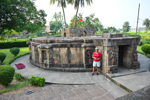Bhubhaneswar, Odisha, India (Nov 2022)
The 'Temple City' of Bhubaneswar once abounded in medieval temples. Over 50 temples still stand in the old city, around the ceremonial tank, Bindu Sagar. The city also has two good museums – Odisha State Museum, State Tribal Museum – an ancient Jaina cave complex, a site with Ashoka's rock edicts, and a Chausath Yogini temple belonging to the tantric religious substrate of early India. Bhubhaneswar is now a noisy and busy regional capital with a distinctive character—a unique mix of the modern, the traditional, and the left-behind.
Lingaraj Temple complex, |
Kalinga architecture, built |
Mukteshwar Temple |
Shiva temple, built by |
The decorated torana |
Exquisitely carved |
"Gem of Kalinga / Odisha |
Posing visitor |
Temple entrance |
Relief sculpture on walls |
Relief sculpture on walls |
Shrine with snake statues |
Parsurameshwara Temple |
Dates from 7th century |
Sculpture on temple walls |
Dedicated to Shiva (more) |
Sukasari Temple, dates |
Dedicated to Shiva |
Sculpture on temple walls |
Chitrakarini Temple, |
Rajarani Temple, from |
A saivaite temple |
Traditional two sectioned |
(1) Deul/Vimana (sanctum) |
Nayikas in various moods |
Nayikas in various moods |
Nayikas in various moods |
Nayikas in various moods |
Bindu Sagar tank |
Modern Hanuman temple |
Sleeping man |
An old town square |
Ananta Basudev Temple |
Dates from the 13th cent |
Dedicated to Lord Krishna |
Commissioned by the |
Kedara Gouri Temple |
Priest inside |
Inner sanctum |
Another shrine |
Chausath Yogini Temple |
|||
A tantric shrine (more) |
Circular, 25 feet diameter |
Roofless architecture |
Dates from 9th century |
Niches w/ deities / yoginis |
64 statues in all |
An area for offerings |
Maintained by the ASI |
Tantric goddesses |
In a variety of moods |
Standing atop vahanas |
Black stone (more) |
Ganeshi |
Male-female Shiva |
Dancing yogini |
One legged (more) |
Dhauli |
|||
Ashoka's rock edicts (info) |
Enclosure (more) |
Shanti Stupa |
View from the hilltop |
Udaygiri and Khandagiri Caves (info) |
|||
From 2nd c. BCE (more) |
Alakapuri Gumpha |
Hathi Gumpha (more) |
Brahmi inscriptions |
Thakurani Gumpha etc. |
Rasui Gumpha |
Haridasa Gumpha |
Jambeshwara Gumpha |
Ganesh Gumpha (info) |
Relief sculpture (detail) |
A water tank atop |
Visitor |
Rani Gumpha |
Richly carved |
||
Khandagiri Caves with a |
One of 15 caves (more) |
Navamuni Gumpha |
Carvings of Tirthankars |
Odisha State Tribal Museum Established in 1953, this museum "celebrates the life and culture of Odisha’s 62 tribal communities." |
|||
Entrance |
Art on museum walls |
Geographic spread (more) |
|
A new interactive exhibit |
Dioramas |
Art on walls (more) |
Art on the walls |
Art on the walls |
Art on the walls |
Art on the walls |
Art on the walls |
Odisha State Museum (info) |
|||
Buddhist heritage (info) |
Tara |
The Buddha |
The Buddha |
Tara (Avalokiteshwar) |
Railing Pillar (Lion) |
The Buddha |
The Buddha (headless) |
Jaina Heritage (info) |
Mahavir (24th Tirthankar) |
Parshvanath |
|
Tara |
Avalokitesvar |
Bajrapani Avalokitesvar |
Manjushree |
Ajitanath (2nd Tirthankar) |
Risabhadeva (1st Tirthankar) |
Lokanath |
Padmapani Avalokitesvar |
Buddhist Stupa |
Varaha |
Vamana |
Visnu (more) |
Krishna-Visnu |
Visnu |
Visnu |
|
Chamunda (more) |
Varahi |
Vaisnavi |
Indrani |
Mahisasuramardini Durga |
Garuda |
Bhairava |
Nataraj |
Uma Mahesvar |
Linga Puja |
Arddhanariswar |
Manasa (more) |
Lakulisha (more) |
Ganesha (info) |
||
Kartikeya (more) |
Ganga |
Yamuna |
Astika-Jaratkaru (more) |
Erotic sculpture |
Amorous couples |
Yaksha and Yakshini |
Surya |
Kuber |
Brahma |
Gajasimha |
Gajavidala |
Hanuman |
Scene of Ramayan |
Arjuna's Archery Test |
Shalabhanjika |
Mandira Charini |
Mandira Charina |
Hero Stone |
Vastra Harana |
Rishi with His Disciples |
Rath Yatra |
Chachakhai |
Dancing Panel |
Transportation of |
Inscription of Satrubhanjadeva |
Punch-marked coins, |
|
Designed in collaboration with Vitalect, Inc. All rights reserved. |












































































































































































